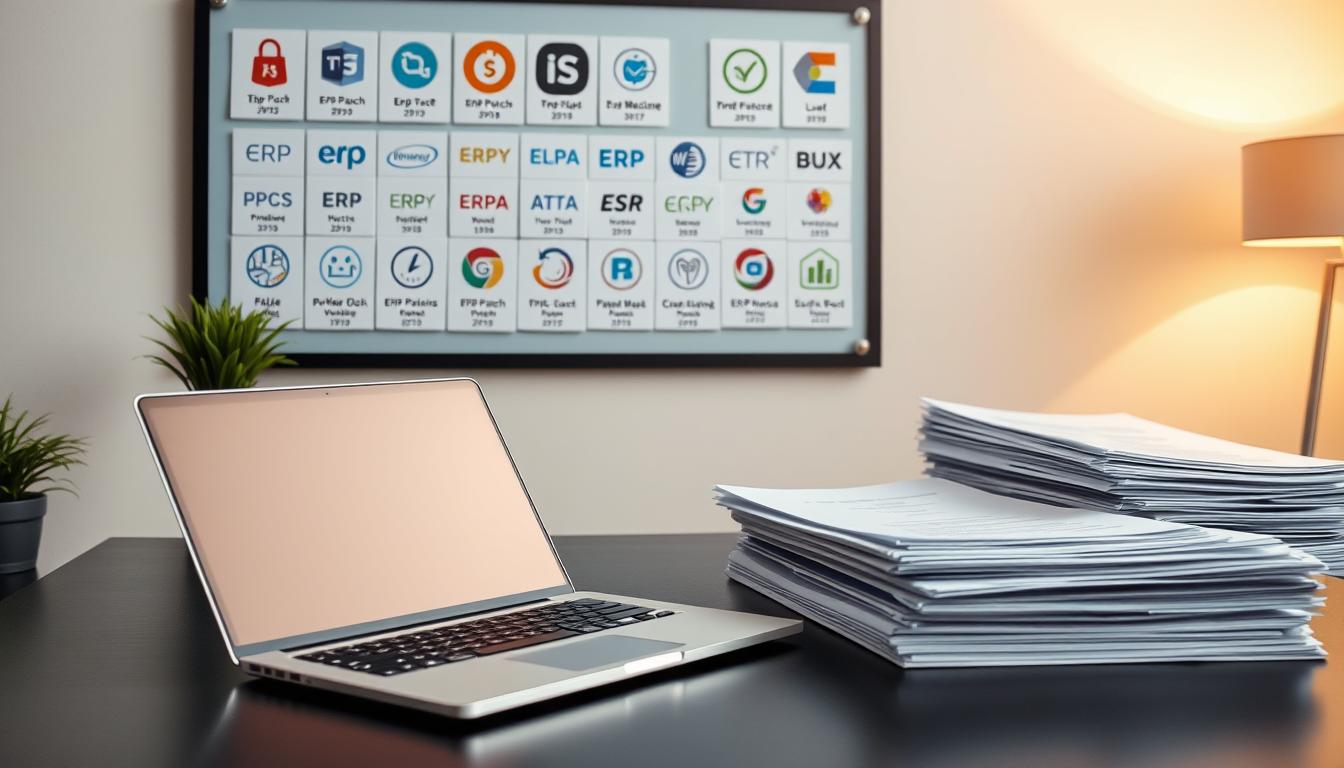Ever thought a simple software update could save your business from big problems? For small and medium enterprises (SMEs) in the Philippines, managing software updates and ERP patches is key. It keeps operations running smoothly and helps stay ahead of the competition.
ERP systems are essential for planning and managing resources. So, handling system maintenance with care is crucial. This article will share the best ways to manage ERP systems. It will help businesses keep their systems up to date and secure.
Key Takeaways
- Understanding the significance of regular software updates for ERP systems.
- Recognizing the risks associated with neglected ERP patches.
- Implementing a structured approach to system maintenance can improve business performance.
- Ensuring that post-implementation support is in place to address any potential issues.
- Staying informed about new software trends that could affect your ERP strategy.
Understanding the Importance of Software Updates in ERP Systems
Keeping ERP systems updated is key for businesses to stay efficient and secure. Updates are vital for smooth and secure system operation. They fix bugs and improve system capabilities, helping businesses stay on track.
The Role of Software Updates in Business Continuity
Regular updates help keep businesses running smoothly. They reduce the chance of system failures and improve performance. Updates also add new features that boost productivity.
By staying up-to-date, businesses protect their data and stay ready for market changes. This proactive approach keeps operations stable and secure.
Consequences of Ignoring ERP Patches
Ignoring updates can cause big problems, like system failures and security risks. Unfixed issues can lead to data breaches, harming a company’s reputation. Cyber threats are becoming more common, making patch management crucial.
Businesses, including small and medium ones in the Philippines, must focus on updates. A proactive approach to updates ensures a safe and stable environment.
Challenges in Managing ERP Software Updates
Updating ERP systems is tough, mainly for small and medium businesses. The main issue is the software’s complexity. As companies grow, so does the ERP system’s size and complexity.
Complexity of ERP Systems
ERP systems are very complex, with lots of features. This makes updates hard because each part has its own needs. As companies get bigger, managing these updates becomes even harder, using up more IT resources.
Frequent Exploits and Cyber Threats
Small and medium businesses face many cyber threats today. With over 4,000 known ERP vulnerabilities, like in SAP and Oracle, the risk is high. To stay safe, companies must update quickly and watch out for new threats.
Key Steps for Effective Patch Management
Managing software updates in ERP systems is key for security and function. Starting with a regular patch cycle is essential. This cycle should fit your organization’s needs. It lowers risks from outdated software and improves performance.
Knowing how to manage patches keeps businesses ahead and safe from threats.
Establishing a Regular Patch Cycle
Having a set patch cycle helps schedule ERP updates well. Regular checks, tests, and updates make the process smoother. This reduces downtime and boosts system reliability.
As needs change, so should your patch schedule. You might need to update more often due to new threats or system changes.
Identifying Critical Updates
Spotting critical updates that need quick action is crucial. These updates fix big security issues or problems that affect work. By watching system alerts and vendor messages, you can focus on the most urgent updates.
Regular checks and monitoring help spot these updates. This way, you won’t miss any important ones.
Understanding ERP Patches: Types and Their Implications
ERP patches are key to making systems better and safer for businesses. Knowing the different types of patches helps companies keep their ERP software up to date. It’s important to know the difference between updates that make things work better and those that keep the system safe.
Functional Updates vs. Security Patches
Functional updates make the ERP system more efficient and able to handle new tasks. They add new features that make processes smoother and improve how users interact with the system.
Security patches, on the other hand, fix weaknesses in the software to protect it from cyber threats. Not applying these patches can put the company at risk of data breaches or legal trouble. So, it’s crucial to update systems regularly.
Legal Compliance and ERP Updates
Legal rules are a big deal when it comes to ERP patches. Industries like finance and healthcare have strict laws to follow. Not keeping up with updates can lead to big legal problems. Companies must make sure their ERP systems meet all legal standards to avoid fines.
For small and medium-sized enterprises (SMEs) in the Philippines, it’s essential to understand the impact of each update. Staying compliant not only keeps the business safe but also builds trust with customers and partners. Keeping up with ERP patches helps companies adjust to new laws quickly.
Post-Implementation Support: Ensuring Seamless ERP Functionality
Post-implementation support is key to keeping ERP systems running smoothly after updates. It’s important to train staff on these updates. This training helps them use the new features and functions well.
This way, employees can work more efficiently. They can take full advantage of the ERP system’s advancements.
Training Staff on Software Updates
Training on updates should be a regular part of managing user experience. Regular workshops keep users up-to-date with changes. This boosts their confidence in using the system.
Hands-on learning sessions help users understand and use the system correctly. Effective ERP management depends on users who can quickly adapt to new features.
Creating a Support Mechanism for Users
A strong support system helps employees when they face issues. Having a dedicated help desk and detailed documentation is very helpful. This setup reduces worries about navigating the system.
In the Philippines, such support greatly improves user experiences. It leads to less disruption during updates. Having a reliable support point makes integrating updates easier.
Best Practices for Testing ERP Updates and Patches
Testing ERP updates and patches is key to keeping systems running smoothly. Using a sandbox environment lets businesses try out new updates safely. This is very important for businesses in the Philippines, where small and medium enterprises need stable IT systems.
The Importance of a Sandbox Environment
A sandbox environment is a safe place for testing ERP updates. It lets businesses check out new patches without risking their work flow. This way, they can be sure updates work well, encouraging innovation without harming core functions.
They can spot problems early and fix them quickly. This makes their patch management better.
Regression Testing for Core Functions
Regression testing is vital to make sure ERP system’s core functions work after updates. It checks if new changes don’t mess up what’s already working. By doing this, businesses avoid problems that could slow them down.
Good testing makes sure updates go smoothly. It keeps systems reliable and efficient.
Monitoring and Troubleshooting After Updates
After updates in ERP systems, it’s crucial to watch closely and fix problems quickly. This step is key to making sure systems work right and solve any issues fast. Using the right methods is vital for keeping systems running smoothly.
Utilizing Log Analysis Tools
Log analysis tools are key for watching ERP systems. They show what’s happening and how well things are working. By checking logs often, admins can spot and fix problems before they get big.
This way, updates work better, and users stay happy.
Feedback Gathering from Users
Getting feedback from users is very important after updates. Talking to users gives us real info about how they’re doing. This feedback can show us problems we might not see from logs alone.
By listening to users, we can fix issues fast. This makes sure the system works well for everyone.
Strategies for Communicating Updates with Stakeholders
Effective communication is key in managing ERP system updates. Clear strategies help keep stakeholders informed and involved. This is crucial during updates and downtime, to avoid disruptions and keep productivity high.
Planning and Scheduling Software Updates
Planning updates means finding the best times to make changes. This is usually during off-peak hours. This way, daily operations are less affected. Telling stakeholders about the schedule in advance helps them get ready.
Important parts of the update plan include:
- Specific timeline for the updates
- Impact assessment on operations
- Expected benefits from the update
Best Practices for Managing Downtime
Effective downtime management means little disruption for stakeholders. This includes sending out timely notifications about downtime. Here are some best practices:
- Use multiple communication channels, such as email, SMS, or internal messaging systems.
- Explain why the updates are important and what benefits they bring.
- Offer an FAQ or resources to answer common downtime questions.
By using these strategies, businesses can make updates smoother. This ensures team members are on the same page with the goals.
Developing an Incident Response Plan for ERP Systems
Creating a good incident response plan for ERP systems is key for companies. It helps them deal with cyber threats and risks. A solid plan makes handling incidents smooth, keeping business running without a hitch. Knowing what the plan includes is vital for managing incidents well in ERP systems.
Steps to Create a Comprehensive Response Plan
Building an incident response plan takes careful steps. Companies should think about these:
- Identify key stakeholders: Get teams from IT, security, and management involved for a full approach.
- Assess risks: Look at possible threats to your ERP systems, like data breaches or system crashes.
- Define roles and responsibilities: Make it clear who does what to handle incidents fast.
- Create response protocols: Set up steps for spotting, dealing with, and fixing incidents.
- Test and update: Do drills often to keep the plan working well against new threats.
Role of IT in Incident Management
IT is crucial in managing incidents. IT teams watch ERP systems, find oddities, and follow the response plan. Their skills are key for quick incident management, which lessens breach damage. Keeping IT teams trained helps them tackle new issues well.
With a good incident response plan, companies can protect their ERP systems. This ensures they keep running smoothly, even when unexpected problems arise.
Conclusion
Managing software updates and patches is key to keeping ERP systems running smoothly and securely. Small and medium-sized enterprises (SMEs) in the Philippines can follow best practices to keep their systems up to date. This ensures their business can keep going without a hitch.
Being proactive in managing updates helps avoid risks and makes operations more efficient. It’s all about being ready for what comes next. This way, businesses can stay ahead of the game in a fast-changing world.
It’s also important to focus on making sure users have a good experience after updates. This means always looking for ways to improve. By doing this, companies can quickly adjust to new technology and stay successful.
In short, keeping updates in check is essential for any business today. It’s not just a job; it’s a key part of planning for success. Companies that do this well will be better prepared for challenges and can achieve long-term success.
FAQ
Why are software updates important for ERP systems?
Software updates are key for ERP systems. They fix bugs, boost performance, and add new features. Regular updates keep businesses running smoothly and protect against security threats.
What are the consequences of ignoring ERP patches?
Ignoring ERP patches can cause big problems. It can lead to system crashes, data breaches, and cyber attacks. Keeping your software up to date is crucial for security and stability.
How can SMEs establish a regular patch management cycle?
SMEs can set up a patch management cycle by looking at their needs and picking important patches. Regular updates help avoid risks and make systems run better.
What types of patches should SMEs focus on?
SMEs should focus on patches that boost performance and security. It’s important to know which updates are key for both performance and legal reasons.
How can businesses support users after ERP updates?
Businesses can help users by offering training on new features. They should also have a support system that’s easy to reach. This helps users get used to changes fast and well.
Why is testing updates in a sandbox environment important?
Testing updates in a sandbox environment is crucial. It lets businesses check new changes without affecting their live systems. This ensures that updates don’t mess with core functions.
What role does ongoing monitoring play after updates?
Ongoing monitoring is key after updates. It helps keep systems stable. By checking logs and listening to user feedback, businesses can fix any problems fast.
How should businesses communicate updates with stakeholders?
Businesses should tell stakeholders about update plans, downtime, and benefits. Doing updates during quiet times can reduce disruptions.
What should be included in an incident response plan for ERP systems?
A good incident response plan should cover how to handle threats and vulnerabilities. It should also outline the roles of IT teams. Being ready can lessen the impact of unexpected problems.



